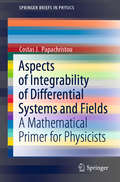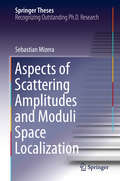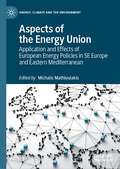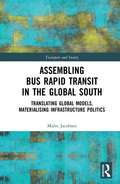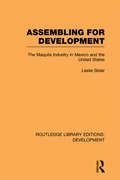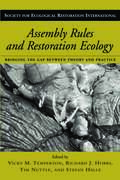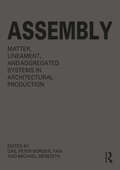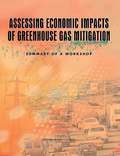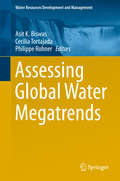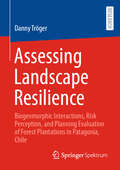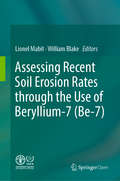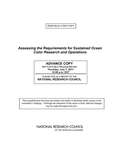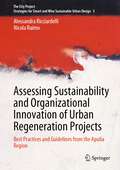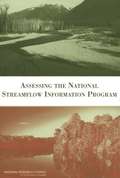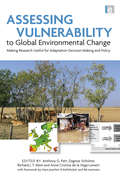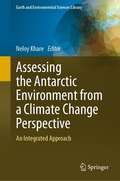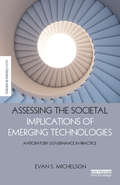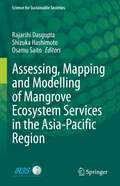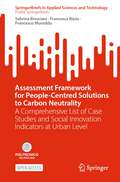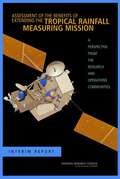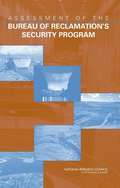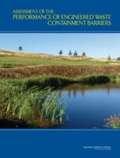- Table View
- List View
Aspects of Integrability of Differential Systems and Fields: A Mathematical Primer for Physicists (SpringerBriefs in Physics)
by Costas J. PapachristouThis book serves as an introduction to the concept of integrability as it applies to systems of differential equations as well as to vector-valued fields. The author focuses on specific aspects of integrability that are often encountered in a variety of problems in applied mathematics, physics and engineering. The following general cases of integrability are examined: (a) path-independence of line integrals of vector fields on the plane and in space; (b) integration of a system of ordinary differential equations by using first integrals; and (c) integrable systems of partial differential equations. Special topics include the integration of analytic functions and some elements from the geometric theory of differential systems. Certain more advanced subjects, such as Lax pairs and Bäcklund transformations, are also discussed. The book is written at an intermediate level for educational purposes. The presentation is as simple as the topics allow, often sacrificing mathematical rigor in favor of pedagogical efficiency.
Aspects of Scattering Amplitudes and Moduli Space Localization (Springer Theses)
by Sebastian MizeraThis thesis proposes a new perspective on scattering amplitudes in quantum field theories. Their standard formulation in terms of sums over Feynman diagrams is replaced by a computation of geometric invariants, called intersection numbers, on moduli spaces of Riemann surfaces. It therefore gives a physical interpretation of intersection numbers, which have been extensively studied in the mathematics literature in the context of generalized hypergeometric functions. This book explores physical consequences of this formulation, such as recursion relations, connections to geometry and string theory, as well as a phenomenon called moduli space localization. After reviewing necessary mathematical background, including topology of moduli spaces of Riemann spheres with punctures and its fundamental group, the definition and properties of intersection numbers are presented. A comprehensive list of applications and relations to other objects is given, including those to scattering amplitudes in open- and closed-string theories. The highlights of the thesis are the results regarding localization properties of intersection numbers in two opposite limits: in the low- and the high-energy expansion. In order to facilitate efficient computations of intersection numbers the author introduces recursion relations that exploit fibration properties of the moduli space. These are formulated in terms of so-called braid matrices that encode the information of how points braid around each other on the corresponding Riemann surface. Numerous application of this approach are presented for computation of scattering amplitudes in various gauge and gravity theories. This book comes with an extensive appendix that gives a pedagogical introduction to the topic of homologies with coefficients in a local system.
Aspects of the Energy Union: Application and Effects of European Energy Policies in SE Europe and Eastern Mediterranean (Energy, Climate and the Environment)
by Michalis MathioulakisThis book provides a comprehensive exploration of some of the most critical issues regarding the EU’s Energy Union policy. Applied European energy policies face a number of challenges ranging from the geopolitics of energy and energy regulation, to climate change, advancing renewable and gas technologies, and consumer empowerment structures. This book takes a multi-dimensional look into some of these vital issues regarding the European energy sector with a special focus on the effects the Energy Union policy has in two sensitive regional systems, Southeastern Europe and the Eastern Mediterranean.Energy, being by definition a multi-disciplinary field, presents a challenge for readers of any specific disciplinary background that need to grasp an overall understanding of the various aspects of this exciting sector. This book’s objective is to offer the opportunity for readers to get a quality, hands-on overview of the Energy Union by the professionals and academics that interact with it on a daily basis.
Assembling Bus Rapid Transit in the Global South: Translating Global Models, Materialising Infrastructure Politics (Transport and Society)
by Malve JacobsenThis book explores the mobile ethnography of Dar es Salaam, where consultants and politicians have planned and implemented a bus rapid transit (BRT) system for two decades. It analyses the dual processes of assembling BRT in the Tanzanian metropolis and establishing BRT as a policy model of and for the Global South. The book elucidates how policy models are constructed and circulated around the globe and depicts the processes by which they are translated between, and materialise within, specific contexts. It presents the case of BRT to demonstrate how technocrats shape these processes through persuasive work aimed at disseminating and stabilising this transport model, and how local actors influence its adaptation in Dar es Salaam. The book adopts a ‘double mobility’ approach to show how this ethnography follows travelling consultants, circulating policies and moving buses to explore the fluidity of the BRT model. Linking key debates in policy mobility studies and Science and Technology Studies, enriched with postcolonial perspectives and geographies of transport and infrastructure, it offers new insights into the technopolitics of planning and implementing infrastructure systems. This book will appeal to academics and students of human geography, transport studies, science and technology studies, and African and development studies interested in the technopolitics of transport planning.
Assembling Nusantara: Mimicry, Friction, and Resonance in the New Capital Development (Advances in 21st Century Human Settlements)
by Lilis Mulyani Henny Warsilah Ivan Kurniawan NasutionToday, the new Indonesian capital city, Nusantara, planning is being anticipated as “representing national identity,” “a model city,” or “a gift to the world,” and many other extraordinary labels. This book examines the reality of an ongoing developmental transformation of the Nusantara beyond those labels. It approaches its assemblage of humans, their works (plans, documents, policies, and others), non-human objects (biodiversity, landscape, geography, physical infrastructure, buildings, and public spaces), processes, social relationships, social infrastructures, and others. It is organized into three themes—mimicry, friction, and resonance. The mimicry illustrates the similarities (and differences) between Nusantara and other capital cities in urban narratives, imageries, and forms. The friction studies how Nusantara moves actors who do not always agree, processes that do not always align or collaboration between diverse contradicting groups that intersect. The resonance observes how Nusantara resonates with, yet communicates its voice toward, the world. The three concepts (originated from geography, anthropology, and sociology) frame the analytics of the various contributions of local and foreign scientists from multiple disciplines. Overall, the book recommends “Otorita Ibu Kota Nusantara” (Nusantara capital city authority) on the current experimentation and implementation of the urban vision and provides a reference for social scientists to study Nusantara. And more broadly, the book offers the current socio-spatial practices of capital city-making in Asia that are valuable for the region.
Assembling Petroleum Production and Climate Change in Ecuador and Norway (Routledge Explorations in Energy Studies)
by Elisabeth Marta TómmerbakkThis book addresses some of the controversies and uncertainties associated with reducing the extensive exploitation of fossil fuels due to their role in global warming. Elisabeth Marta Tómmerbakk explores why a transition towards a post-carbon society is so difficult to accomplish by examining how the relationship between petroleum production and climate change is politically framed and negotiated in contested cases. This question is approached through a process-oriented comparative case study of Lofoten, located in the Norwegian Sea above the Arctic Circle, and Yasuní-ITT (Ishpingo, Tambococha, and Tiputini) located in the Ecuadorian Amazon: regions that both belong to oil-exporting countries with highly oil-dependent economies. Tómmerbakk draws on rich empirical data that includes qualitative interviews with subjects in both countries and applies an Actor-Network Theory framework to show that oil and climate are intricately entangled in knowledge and policy practices. Overall, Assembling Petroleum Production and Climate Change in Ecuador and Norway provides an in-depth examination of how climate science and petroleum extraction are negotiated, adapted, assembled, and coordinated with other national policies and political aims. This book will be of great interest to students and scholars of petroleum production, climate change, environmental policy, and environmental sociology.
Assembling for Development: The Maquila Industry in Mexico and the United States (Routledge Library Editions: Development #No. 5)
by Leslie SklairFirst published in 1989, this book focuses upon the phenomenon of export-led industrialisation fuelled by foreign investment and technology. He concentrates on Mexico, where US companies have been taking advantage of inexpensive labour to establish "maquila" factories that assemble US parts for export. Through this detailed study of the maquila industry, Sklair charts the progress from the political imperialism of colonial days to the economic imperialism of today.
Assembly Rules and Restoration Ecology: Bridging the Gap Between Theory and Practice (Science Practice Ecological Restoration #5)
by Richard J. Hobbs Vicky M. Temperton Tim Nuttle Stefan HalleUnderstanding how ecosystems are assembled -- how the species that make up a particular biological community arrive in an area, survive, and interact with other species -- is key to successfully restoring degraded ecosystems. Yet little attention has been paid to the idea of assembly rules in ecological restoration, in both the scientific literature and in on-the-ground restoration efforts. Assembly Rules and Restoration Ecology, edited by Vicky M. Temperton, Richard J. Hobbs, Tim Nuttle, and Stefan Halle, addresses that shortcoming, offering an introduction, overview, and synthesis of the potential role of assembly rules theory in restoration ecology. It brings together information and ideas relating to ecosystem assembly in a restoration context, and includes material from a wide geographic range and a variety of perspectives. Assembly Rules and Restoration Ecology contributes new knowledge and ideas to the subjects of assembly rules and restoration ecology and represents an important summary of the current status of an emerging field. It combines theoretical and practical aspects of restoration, making it a vital compendium of information and ideas for restoration ecologists, professionals, and practitioners.
Assembly: Matter, Lineament, and Aggregated Systems in Architectural Production
by Michael Meredith Gail Peter BordenPart-to-part relationships and the approach to governing their sensibilities is at the root of all architecture. The need for engaging in a dialogue around these systems is essential to contemporary architectural discourse and practice. Assembly builds on and extends the investigations of materials and representation techniques in the editors’ previous books, Matter and Lineament. This book uses a collection of detailed case studies, explained by first-person authors, about experimental and innovative takes on assembling architecture. Bridging theory and practice, 17 projects and their principled approaches each demonstrate an important vein of inquiry within the topic. Essays probe issues such as latent and overt geometry, fabrication and technology, part-to-part elements, joinery and representation, material vernacular geometries, labor and place-based contextual assemblies, detailing, and pedagogical examinations. This text articulates the traditions and trends of material as the defining premise in the contemporary making of architecture. Its outcomes are applicable to beginning students of architecture and advanced practitioners alike.
Asserting Native Resilience: Pacific Rim Indigenous Nations Face the Climate Crisis
by Alan Parker Zoltán GrossmanIndigenous nations are on the front line of the climate crisis. With cultures and economies among the most vulnerable to climate-related catastrophes, Native peoples are developing twenty-first century responses to climate change that serve as a model for Natives and non-Native communities alike. Native American tribes in the Pacific Northwest and Indigenous peoples around the Pacific Rim have already been deeply affected by droughts, flooding, reduced glaciers and snowmelts, seasonal shifts in winds and storms, and the northward movement of species on the land and in the ocean. Using tools of resilience, Native peoples are creating defenses to strengthen their communities, mitigate losses, and adapt where possible. Asserting Native Resilience presents a rich variety of perspectives on Indigenous responses to the climate crisis, reflecting the voices of more than twenty contributors, including tribal leaders, scientists, scholars, and activists from the Pacific Northwest, British Columbia, Alaska, and Aotearoa / New Zealand, and beyond. Also included is a resource directory of Indigenous governments, NGOs, and communities and a community organizing booklet for use by Northwest tribes.
Assessing Economic Impacts of Greenhouse Gas Mitigation: Summary of a Workshop
by National Research Council of the National AcademiesMany economic models exist to estimate the cost and effectiveness of different policies for reducing greenhouse gas (GHG) emissions. Some approaches incorporate rich technological detail, others emphasize the aggregate behavior of the economy and energy system, and some focus on impacts for specific sectors. Understandably, different approaches may be better positioned to provide particular types of information and may yield differing results, at times rendering decisions on future climate change emissions and research and development (R&D) policy difficult. Reliable estimates of the costs and benefits to the U.S. economy for various emissions reduction and adaptation strategies are critical to federal climate change R&D portfolio planning and investment decisions. At the request of the U.S. Department of Energy (DOE), the National Academies organized a workshop to consider these issues. The workshop, summarized in this volume, comprised three dimensions: policy, analysis, and economics. Discussions along these dimensions were meant to lead to constructive identification of gaps and opportunities. The workshop focused on (1) policymakers' informational needs; (2) models and other analytic approaches to meet these needs; (3) important economic considerations, including equity and discounting; and (4) opportunities to enhance analytical capabilities and better inform policy.
Assessing Global Water Megatrends (Water Resources Development and Management)
by Asit K. Biswas Cecilia Tortajada Philippe RohnerThis book highlights what are likely to be the future megatrends in the water sector and why and how they should be incorporated to improve water governance in the coming decades. In this first ever book on megatrends for the water sector, 22 leading world experts from different disciplines representing academia, business, government, national and international organisations discuss what the major megatrends of the future are and how they will radically change water governance in the coming decades.
Assessing Landscape Resilience: Biogeomorphic Interactions, Risk Perception, and Planning Evaluation of Forest Plantations in Patagonia, Chile
by Danny TrögerThis book examines the extent to which exotic pine plantations are a suitable strategy for maintaining the essential functions, structures, processes and identity of the Patagonian landscape over time. To this end, it integrates three empirical studies with inter- and transdisciplinary approaches under the theoretical framework of landscape resilience. The first study analyses the biogeomorphic interactions of different land uses and their relevance for soil conservation and landslide mitigation. The second study examines perceptions of natural hazards and focuses on networks of human and non-human actors that maintain landscape resilience. The results of these two studies are incorporated into the planning evaluation of land zoning and alternative strategies are developed, inspired by normative polycentric governance. It is concluded that Pinus plantations partially fulfil their ecological objectives of erosion control and landslide mitigation. However, their performance lags behind that of secondary forests with native species and they create new risks such as reduced biodiversity, increased risk of wildfires and conflicts with local identity. The book concludes with new research questions of trans-regional importance.
Assessing Recent Soil Erosion Rates through the Use of Beryllium-7 (Be-7)
by William Blake Lionel MabitThis open access book is the first comprehensive guideline for the beryllium-7 (Be-7) technique that can be applied to evaluate short-term patterns and budgets of soil redistribution in agricultural landscapes. While covering the fundamental and basic concepts of the approach, this book distinguishes itself from other publications by offering step-by-step instructions on how to use this isotopic technique effectively. It covers experimental design considerations and clear instruction is given on data processing. As accurate laboratory measurement is crucial to ensure successful use of Be-7 to investigate soil erosion, a full chapter is devoted to its specific determination by gamma spectrometry. This open access contribution further describes new developments in the Be-7 technique and includes a concluding chapter highlighting its potential benefits to support the implementation of area-wide soil conservation policy.
Assessing Requirements for Sustained Ocean Color Research and Operations
by The National Academy of SciencesThe ocean is a fundamental component of the earth's biosphere. It covers roughly 70 percent of Earth's surface and plays a pivotal role in the cycling of life's building blocks, such as nitrogen, carbon, oxygen, and sulfur. The ocean also contributes to regulating the climate system. Most of the primary producers in the ocean comprise of microscopic plants and some bacteria; and these photosynthetic organisms (phytoplankton) form the base of the ocean's food web. Monitoring the health of the ocean and its productivity is critical to understanding and managing the ocean's essential functions and living resources. Because the ocean is so vast and difficult for humans to explore, satellite remote sensing of ocean color is currently the only way to observe and monitor the biological state of the surface ocean globally on time scales of days to decades. Ocean color measurements reveal a wealth of ecologically important characteristics including: chlorophyll concentration, the rate of phytoplankton photosynthesis, sediment transport, dispersion of pollutants, and responses of oceanic biota to long-term climate changes. Continuity of satellite ocean color data and associated climate research products are presently at significant risk for the U. S. ocean color community. Assessing Requirements for Sustained Ocean Color Research and Operationsaims to identify the ocean color data needs for a broad range of end users, develop a consensus for the minimum requirements, and outline options to meet these needs on a sustained basis. The report assesses lessons learned in global ocean color remote sensing from the SeaWiFS/MODIS era to guide planning for acquisition of future global ocean color radiance data to support U. S. research and operational needs.
Assessing Sustainability and Organizational Innovation of Urban Regeneration Projects: Best Practices and Guidelines from the Apulia Region (The City Project #3)
by Alessandra Ricciardelli Nicola RaimoThis book offers the first comprehensive report on the topic of organizational innovation and sustainability of urban regeneration from the public manager's perspective. Starting from a rich set of case studies on urban regeneration from the region of Apulia, in Italy, it develops a framework for measuring their sustainability performance. It proposes the use of indicators related to different aspects of the urban regeneration process, including the participations of stakeholders; land use and buildings; economy and jobs; transportation; environmental pollution; energy use; waste management; as well as open spaces and wildlife. This book offers extensive information to graduate students and researchers, and to authorities, developers, investors and stakeholders alike, involved in the design, planning and management, and sustainable development of urban spaces. It is expected to foster a better understanding of the level of organizational innovation and sustainability of urban regeneration projects and the role of governing bodies in their implementation.
Assessing The National Streamflow Information Program
by Committee on Review of the USGS National Streamflow Information ProgramFrom warning the public of impending floods to settling legal arguments over water rights, the measurement of streamflow (“streamgaging”) plays a vital role in our society. Having good information about how much water is moving through our streams helps provide citizens with drinking water during droughts, control water pollution, and protect wildlife along our stream corridors. The U.S. Geological Survey’s (USGS) streamgaging program provides such information to a wide variety of users interested in human safety, recreation, water quality, habitat, industry, agriculture, and other topics. For regional and national scale streamflow information needs, the USGS has created a National Streamflow Information Program (NSIP). In addition to streamgaging, the USGS envisions intensive data collection during floods and droughts, national assessments of streamflow characteristics, enhanced information delivery, and methods development and research. The overall goals of the program are to: meet legal and treaty obligations on interstate and international waters, support flow forecasting; measure river basin outflows, monitor sentinel watersheds for long-term trends in natural flows, and measure flows for water quality needs. But are these the right topics to collect data on? Or is the USGS on the wrong track? In general, the book is supportive of the design and content of NSIP, including its goals and methodology for choosing stream gages for inclusion in the program. It sees the ultimate goal of NSIP as developing the ability to use existing data-gathering sites to generate streamflow information with quantitative confidence limits at any location in the nation. It is just as important to have good measurements during droughts as during floods, and it therefore recommends supporting Natural Resource Conservation Service forecast sites in addition to those of the National Weather Service.
Assessing Vulnerability to Global Environmental Change: Making Research Useful for Adaptation Decision Making and Policy
by Richard J. Klein Anthony G. PattAssessing the vulnerability of human populations to global environmental change, particularly climate change, is now the main imperative of research and international action. However, much of the research into vulnerability is not designed to feed directly into decision making and policy, creating a gap between the knowledge created by researchers and what is required by decision makers. This book seeks to rectify this problem and bridge the gap. It discusses vulnerability as the central theme and brings together many different applications from disaster studies, climate change impact studies and several other fields and provides the most comprehensive synthesis of definitions, theories, formalization and applications to date, illustrated with examples from different disciplines, regions and periods, and from local through to regional, national and international levels. Case study topics cover sea level rise, vulnerability to changes in ecosystem services, assessing the vulnerability of human health and 'double exposure' to climate change and trade liberalization amongst other issues. Research outcomes stress that science-policy dialogues must be transparent to be effective and concentrate on a mutual understanding of the concepts used. A key research finding is that the most useful information for decision makers is that which shows the separate causes and drivers of vulnerability, rather than presenting vulnerability in an aggregated form. The book concludes with a unifying framework for analysing integrated methodologies of vulnerability assessment and guiding how research and policy can be linked to reduce vulnerability.
Assessing the Antarctic Environment from a Climate Change Perspective: An Integrated Approach (Earth and Environmental Sciences Library)
by Neloy KhareThe present book covers diversified contributions addressing the impact of climate change on the Antarctic environment. It covers the reconstruction of environmental changes using different proxies. The chapters focus on the glacial history, glacial geomorphology, sedimentology, and geochemistry of Antarctic region. Furthermore, the Cenozoic evolution of the Antarctic ice sheet is discussed along with a Scientometrics analysis of climate change research. The book serves as a useful reference for researchers who are fascinated by the polar region and environmental research.
Assessing the Societal Implications of Emerging Technologies: Anticipatory governance in practice (The Earthscan Science in Society Series)
by Evan S. MichelsonA growing problem of interest in the field of science and technology policy is that the next generation of innovations is arriving at an accelerating rate, and the governance system is struggling to catch up. Current approaches and institutions for effective technology assessment are ill suited and poorly designed to proactively address the multidimensional, interconnected societal impacts of science and technology advancements that are already taking place and expected to continue over the course of the 21st century. This book offers tangible insights into the strategies deployed by well-known, high-profile organizations involved in anticipating the various societal and policy implications of nanotechnology and synthetic biology. It focuses predominantly on an examination of the practices adopted by the often-cited and uniquely positioned Project on Emerging Nanotechnologies in the United States, as well as being informed by comparisons with a range of institutions also interested in embedding forward-looking perspectives in their respective area of innovation. The book lays out one of the first actionable roadmaps that other interested stakeholders can follow when working toward institutionalizing anticipatory governance practices throughout the policymaking process.
Assessing, Mapping and Modelling of Mangrove Ecosystem Services in the Asia-Pacific Region (Science for Sustainable Societies)
by Rajarshi Dasgupta Osamu Saito Shizuka HashimotoThis book presents the state-of-the-art of knowledge in assessing, mapping, and modeling mangrove ecosystem services and outlines various scientific tools and techniques, including environmental scenario-building, spatial and econometric modelling to understand the fluctuations and future availability of mangrove ecosystem services. The book also highlights the current gaps and measures in policy planning and outlines the avenues for capacity building. Through case studies and thematic reviews, the book plans to cater to a wide range of audiences, including students, researchers, and decision-makers at various levels involved in mangrove conservation and land use optimization for sustainable and resilient development. This book is particularly useful to researchers and students in the field of landscape and spatial ecology, coastal zone management, ecosystem services, and resilience planning. It is also a must-read for policymakers, conservators, coastal zone managers, foresters, and general administrators in understanding the current and future roles of mangroves in ecosystem-based adaptation through informed decision-making.
Assessment Framework for People-Centred Solutions to Carbon Neutrality: A Comprehensive List of Case Studies and Social Innovation Indicators at Urban Level (SpringerBriefs in Applied Sciences and Technology)
by Francesca Rizzo Sabrina Bresciani Francesco MuredduThis open access book presents a catalogue of over one thousand indicators which can be used by cities' public administrators to monitor and evaluate social innovation action plans to support people-centred, collaborative or co-designed solutions to lower carbon emissions. Indicators are clustered according to a framework of social innovation solutions for climate neutrality at city level, developed by merging top-down academic knowledge with bottom-up pragmatic case studies. There is currently limited guidance on how to embed social innovations in their cities’ action plans with the aim of reaching climate neutrality, and on how to assess the progress and impacts of such people-centred projects in cities. The book addresses this gap and is thus relevant for scholars in the field of policy-making and design, as well as cities’ transition teams, policymakers and consultants. Based on the work developed within the EU-funded project NetZeroCities, intervention logics are provided for each of the ten categories of action, with related indicators clustered by category and evaluation criteria (effectiveness, efficiency, relevance, replicability, and scalability). Guidelines to implement the framework support city administrators in defining steps they need to follow to apply the indicators to their local case, making social innovation a crucial lever for accelerating systemic transformation.
Assessment Of The Benefits Of Extending The Tropical Rainfall Measuring Mission: A Perspective From The Research And Operations Communities
by National Research Council of the National AcademiesLaunched jointly in 1997 by the National Aeronautics and Space Administration (NASA) and the Japan Aerospace Exploration Agency (JAXA), the Tropical Rainfall Measuring Mission (TRMM) is a satellite mission that placed a unique suite of instruments, including the first precipitation radar, in space. These instruments are used to monitor and predict tropical cyclone tracks and intensity, estimate rainfall, and monitor climate variability (precipitation and sea surface temperature). TRMM has been collecting data for seven years; this data is used by the Joint Typhoon Warning Center, the National Center for Environmental Prediction, and the National Hurricane Center, among others worldwide. In July 2004, NASA announced that it would terminate TRMM in August 2004. At the request of the National Oceanic and Atmospheric Administration (NOAA), the White House, and the science community, NASA agreed to continue TRMM operations through the end of 2004. Meanwhile, NASA asked a National Research Council (NRC) committee to provide advice on the benefits of keeping TRMM in operation beyond 2004. After holding a workshop with a number of experts in the field, the committee found that TRMM will contribute significantly to operations and science if the mission is extended; and therefore, strongly recommends continued operation of TRMM with the caveat that cost and risk will need to be further examined before a final decision about the future of TRMM can be made.
Assessment Of The Bureau Of Reclamation's Security Program
by National Research Council of the National AcademiesThe water impounded behind a dam can be used to generate power and to provide water for drinking, irrigation, commerce, industry, and recreation. However, if a dam fails, the water that would be unleashed has the energy and power to cause mass destruction downstream, killing and injuring people and destroying property, agriculture, industry, and local and regional economies. The U.S. Bureau of Reclamation (Reclamation) is responsible for managing and operating some of this nation’s largest and most critical dams. The failure of one or more of these dams as the result of a malicious act would come with little warning and a limited time for evacuation. In the years since the 9/11 attacks, Reclamation has invested significant resources to establish and build a security program. Reclamation is now ready to evaluate the results of these efforts and determine how best to move forward to develop a security program that is robust and sustainable. This book assesses Reclamation’s security program and determines its level of preparedness to deter, respond to, and recover from malicious acts to its physical infrastructure and to the people who use and manage it.
Assessment Of The Performance Of Engineered Waste Containment Barriers
by National Research Council of the National AcademiesPresident Carter’s 1980 declaration of a state of emergency at Love Canal, New York, recognized that residents’ health had been affected by nearby chemical waste sites. The Resource Conservation and Recovery Act, enacted in 1976, ushered in a new era of waste management disposal designed to protect the public from harm. It required that modern waste containment systems use “engineered” barriers designed to isolate hazardous and toxic wastes and prevent them from seeping into the environment. These containment systems are now employed at thousands of waste sites around the United States, and their effectiveness must be continually monitored. Assessment of the Performance of Engineered Waste Containment Barriers assesses the performance of waste containment barriers to date. Existing data suggest that waste containment systems with liners and covers, when constructed and maintained in accordance with current regulations, are performing well thus far. However, they have not been in existence long enough to assess long-term (postclosure) performance, which may extend for hundreds of years. The book makes recommendations on how to improve future assessments and increase confidence in predictions of barrier system performance which will be of interest to policy makers, environmental interest groups, industrial waste producers, and industrial waste management industry.
